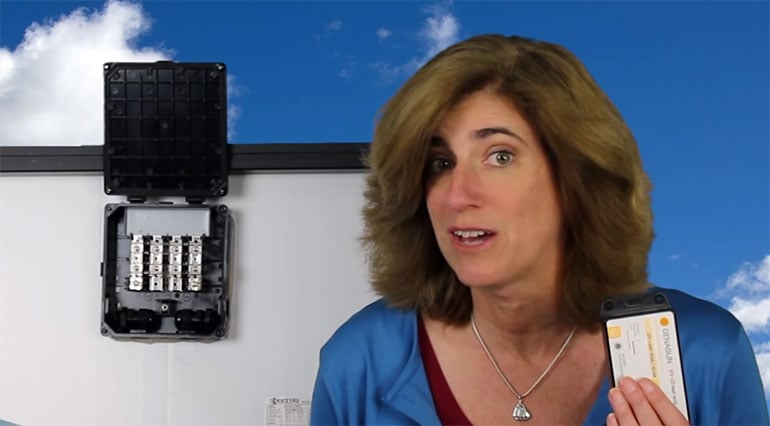
What is a diode?
A diode is designed to let current flow in one direction. If you’re familiar with plumbing, a diode is the electrical equivalent to a check valve. There are two purposes of diodes in a solar power system – bypass diodes and blocking diodes. The same type of diode is generally used for both, a Schottky barrier diode, but how they are wired and what they do is what makes them different.
Bypass diodes
Bypass diodes are used to reduce the power loss solar panels experience due to shading. Because current flows from high to low voltage, when a solar panel has cells that are partially shaded, the current is then forced through the low-voltage shaded cells. This causes the solar panel to heat up, and have severe power loss. Those shaded solar cells become consumers of electricity instead of producers.
Bypass diodes inside the junction box of a solar panel provide a low resistance path for the current to go around a series of solar cells that have been shaded. The diode is wired in parallel with the cells. Because electricity takes the path of least resistance, it is easier for the current to go through the diode than through the shaded cell, so it does. This minimizes the heat gain, and reduces current loss.
Most solar panels have bypass diodes built in these days, so you typically won’t have to worry about that anymore. However, if you have multiple solar panels wired together in series, and you consistently have shading on one or more of the solar panels, wiring a bypass diode in parallel across the shaded panel can prevent the current from being forced back through the shaded panel and cause it to heat and lose power. So, it acts the same as the internal bypass diodes, but bypasses the entire panel instead of the individual cells.
Blocking diodes
Blocking diodes are used to prevent your batteries from discharging backwards through your solar panels at night. Again, current flows from high to low-voltage, so during a sunny day, the voltage of a solar panel will be higher than the voltage of a deep cycle battery and the current will naturally flow from the panel to the battery. But at night, if the solar panel is connected directly to a battery, the voltage of the solar panel is going to be lower than the voltage of the battery, so there is a possibility of some backwards flow, pulling power out of the battery. It won’t be as much as the flow during the day, but there may be some.
As a result, in the days before charge controllers, people would put a blocking diode in series between the battery and the solar panel, only allowing power to go into the battery. Nowadays, most solar power systems have a charge controller between the solar panel and the battery, and this charge controller prevents this backflow of electricity, eliminating the need for a blocking diode.
There may be, however, some instances when a blocking diode can still be helpful. Watch our video below to learn more.

after watching Amy,s video on diodes my thoughts were how do I protect my panels from an EMP? thanx Amy, your teaching videos guided me threw the learning curve, coming to you from Sugarloaf mtn.
There are several articles you can find online with suggestions of how to protect the solar equipment from electromagnetic pulses. The solar panels will likely be least affected, it’s more the electronics like the charge controller and inverter that would be potentially susceptible. If it is a concern of yours, you can google “EMP and solar” to find some good articles. Amy – from Sunday River (someday bigger)
Another great vid there Amy!